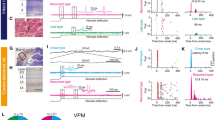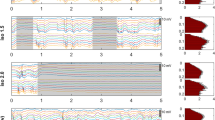Abstract
Indications for a pivotal role of the thalamocortical network in producing the state of anesthesia have come from in vivo animal studies as well as imaging studies in humans. We studied possible synaptic mechanisms of anesthesia-induced suppression of touch perception in the rat’s thalamus. Thalamocortical relay neurons (TCNs) receive ascending and descending glutamatergic excitatory inputs via NMDA and non-NMDA receptors (AMPAR) and are subjected to GABAAergic inhibitory input which shapes the sensory information conveyed to the cortex. The involvement of these synaptic receptors in the suppressive effects of the prototypic volatile anesthetic isoflurane was assessed by local iontophoretic administration of receptor agonists/antagonists during extracellular recordings of TCNs of the ventral posteromedial nucleus responding to whisker vibration in rats anesthetized with isoflurane concentrations of ∼0.9 vol.% (baseline) and ∼1.9 vol.% (ISO high). ISO high induced a profound suppression of response activity reflected by a conversion of the sustained vibratory responses to ON responses. Administration of NMDA, AMPA, or GABAAR antagonists caused a reversal to sustained responses in 88, 94 and 88% of the neurons, respectively, with a recovery to baseline levels of response activity. The data show that the block of thalamocortical transfer of tactile information under ISO high may result from an enhancement of GABAAergic inhibition and/or a reduction of glutamatergic excitation. Furthermore, they show that the ascending vibratory signals still reach the thalamic neurons under the high isoflurane concentration, indicating that this input is resistant to isoflurane while the attenuation of excitation may be brought about at the corticothalamic glutamatergic facilitatory input.






Similar content being viewed by others
References
Alkire MT, Haier RJ, Fallon JH (2000) Toward a unified theory of narcosis: brain imaging evidence for a thalamocortical switch as the neurophysiologic basis of anesthetic-induced unconsciousness. Conscious Cogn 9:370–386
Alloway KD, Wallace MB, Johnson MJ (1994) Cross-correlation analysis of cuneothalamic interactions in the rat somatosensory system: influence of receptive field topography and comparisons with thalamocortical interactions. J Neurophysiol 72:1949–1972
Antognini JF, Buonocore MH, Disbrow EA, Carstens E (1997) Isoflurane anesthesia blunts cerebral responses to noxious and innocuous stimuli: a fMRI study. Life Sci 61:PL349–PL354
Carla V, Moroni F (1992) General anaesthetics inhibit the responses induced by glutamate receptor agonists in the mouse cortex. Neurosci Lett 146:21–24
Darian-Smith I, Rowe MJ, Sessle BJ (1968) “Tactile” stimulus intensity: information transmission by relay neurons in different trigeminal nuclei. Science 160:791–794
Debarbieux F, Brunton J, Charpak S (1998) Effect of bicuculline on thalamic activity: a direct blockade of IAHP in reticularis neurons. J Neurophysiol 79:2911–2918
Deschênes M, Paradis M, Roy JP, Steriade M (1984) Electrophysiology of neurons of lateral thalamic nuclei in cat: resting properties and burst discharges. J Neurophysiol 51:1196–1219
De Sousa SL, Dickinson R, Lieb WR, Franks NP (2000) Contrasting synaptic actions of the inhalational general anesthetics isoflurane and xenon. Anesthesiology 92:1055–1066
Destexhe A (2000) Modelling corticothalamic feedback and the gating of the thalamus by the cerebral cortex. J Physiol (Paris) 94:391–410
Detsch O, Vahle-Hinz C, Kochs E, Siemers M, Bromm B (1999) Isoflurane induces dose-dependent changes of thalamic somatosensory information transfer. Brain Res 829:77–89
Detsch O, Vahle-Hinz C, Kochs E, Siemers M, Bromm B (2001) Differential susceptibility of successive stages of the somatosensory pathway to isoflurane anesthesia. Europ J Anaesthesiol 18 Suppl. 21:A-218
Detsch O, Kochs E, Siemers M, Bromm B, Vahle-Hinz C (2002a) Differential effects of isoflurane on excitatory and inhibitory synaptic inputs to thalamic neurones in vivo. Br J Anaesth 89:294–300
Detsch O, Reeker W, Siemers M, Kochs E, Bromm B (2002b) Suppression of tactile information transfer by isoflurane within the central nervous system. In: Urban BW, Barann M (eds) Molecular and basic mechanisms of anesthesia. Pabst Sci Publ, Lengerich pp 484–492
Ghosh S, Murray GM, Turman AB, Rowe MJ (1994) Corticothalamic influences on transmission of tactile information in the ventroposterolateral thalamus of the cat: effect of reversible inactivation of somatosensory cortical areas I and II. Exp Brain Res 100:276–286
Golshani P, Liu X-B, Jones EG (2001) Differences in quantal amplitude reflect GluR4-subunit number at corticothalamic synapses on two populations of thalamic neurons. PNAS 98:4172–4177
Gottschaldt K-M, Young DW (1977a) Properties of different functional types of neurons in the cat’s rostral trigeminal nuclei responding to sinus hair stimulation. J Physiol 272:57–84
Gottschaldt K-M, Young DW (1977b) Quantitative aspects of responses in trigeminal relay neurones and interneurones following mechanical stimulation of sinus hairs and skin in the cat. J Physiol 272:85–103
Hartings JA, Simons DJ (2000) Inhibition suppresses transmission of tonic vibrissa-evoked activity in the rat ventrobasal thalamus. J Neurosci 20 RC100:1–5
Hentschke H, Schwarz C, Antkowiak B (2005) Neocortex is the major target of sedative concentrations of volatile anaesthetics: strong depression of firing rates and increase of GABAA receptor-mediated inhibition. Eur J Neurosci 21:93–102
Heyer EJ, Nowak LM, Macdonald RL (1981) Bicuculline: a convulsant with synaptic and nonsynaptic effects. Neurology 31:381–1390
Hicks TP (1984) The history and development of microiontophoresis in experimental neurobiology. Prog Neurobiol 22:185–240
Hicks TP, Metherate R, Landry P, Dykes RW (1986) Bicuculline-induced alterations of response properties in functionally identified ventroposterior thalamic neurones. Exp Brain Res 63:248–264
Hoffmann WE, Edelman G, Kochs E, Werner C, Segil L, Albrecht RF (1991) Cerebral autoregulation in awake versus isoflurane-anesthetized rats. Anesth Analg 73:753–757
Hoogland PV, Wouterlood FG, Welker E, Van der Loos H (1991) Ultrastructure of giant and small thalamic terminals of cortical origin: a study of the projections from the barrel cortex in mice using Phaseolus vulgaris leuco-agglutinin (PHA-L). Exp Brain Res 87:159–172
Ito M (1988) Response properties and topography of vibrissa-sensitive VPM neurons in the rat. J Neurophysiol 60:1181–1197
Jahnsen H, Llinás R (1984) Electrophysiological properties of guinea-pig thalamic neurones: an in vitro study. J Physiol 349:205–226
Khakh BS, Henderson G (2000) Modulation of fast synaptic transmission by presynaptic ligand-gated cation channels. J Autonom Nerv Sys 81:110–121
Krasowski MD, Harrison NL (1999) General anesthetic actions on ligand-gated ion channels. Cell Mol Life Sci 55:1278–1303
Lee SM, Friedberg MH, Ebner FF (1994a) The role of GABA-mediated inhibition in the rat ventral posterior medial thalamus: I. Assessment of receptive field changes following thalamic reticular nucleus lesions. J Neurophysiol 71:1702–1715
Lee SM, Friedberg MH, Ebner FF (1994b) The role of GABA-mediated inhibition in the rat ventral posterior medial thalamus: II. Differential effects of GABAA and GABAB receptor antagonists on responses of VPM neurons. J Neurophysiol 71:1716–1726
MacIver MB (1997) General anesthetic actions on transmission at glutamate and GABA synapses. In: Yaksh TL (ed) Anesthesia: biologic foundations. Lippincott-Raven, Philadelphia pp 277–286
McCormick DA (1992) Neurotransmitter actions in the thalamus and cerebral cortex and their role in neuromodulation of thalamocortical activity. Prog Neurobiol 39:337–388
Mineff EM, Weinberg RJ (2000) Differential synaptic distribution of AMPAR subunits in the ventral posterior and reticular thalamic nuclei of the rat. Neurosci 101:969–982
Minnery BS, Simons DJ (2003) Response properties of whisker-associated trigeminothalamic neurons in rat nucleus principalis. J Neurophysiol 89:40–56
Mihic SJ, Ye Q, Wick MJ, Koltchine VV, Krasowski MD, Finn SE, Mascia MP, Valenzuela CF, Hanson KK, Greenblatt EP, Harris RA, Harrison NL (1997) Sites of alcohol and volatile anaesthetic action on GABAA and glycine receptors. Nature 389:385–389
Pearce RA (2003) General anesthetic effects on GABAA receptors. In: Antognini JF, Carstens EE, Raines DE (eds) Neural mechanisms of anesthesia. Humana, Totowa pp 265–282
Peoples RW, Weight FF (1997) Anesthetic actions on excitatory amino acid receptors. In: Yaksh TL (ed) Anesthesia: biologic foundations. Lippincott-Raven, Philadelphia, pp 239–258
Perouansky M, Antognini JF (2003) Glutamate receptors: physiology and anesthetic pharmacology. In: Antognini JF, Carstens EE, Raines DE (eds) Neural mechanisms of anesthesia. Humana, Totowa pp 319–332
Perouansky M, Hemmings HC, Pearce RA (2004) Anesthetic effects on glutamatergic neurotransmission: Lessons learned from a large synapse. Anesthesiology 100:470–472
Salt TE, Eaton SA (1996) Functions of ionotropic and metabotropic glutamate receptors in sensory transmission in the mammalian thalamus. Prog Neurobiol 48:55–72
Seutin V, Johnson SW (1999) Recent advances in the pharmacology of quaternary salts of bicuculline. Trends Pharmacol Sci 20:268–270
Sherman SM, Guillery RW (1996) Functional organization of thalamocortical relays. J Neurophysiol 76:1367–1395
Steriade M, Jones EG, McCormick DA (1997) Thalamus. vol. I. Organisation and function. Elsevier, Amsterdam
Topf N, Jenkins A, Baron N, Harrison NL (2003) Effects of isoflurane on gamma-aminobutyric acid type A receptors activated by full and partial agonists. Anesthesiology 98:306–311
Vahle-Hinz C, Gottschaldt KM (1983) Principal differences in the organization of the thalamic face representation in rodents and felids. In: Macchi G, Rustioni A, Spreafico R (eds) Somatosensory integration in the thalamus. Elsevier, Amsterdam pp 125–145
Vahle-Hinz C, Hicks TP (2003) Temporal shaping of phasic neuronal responses by GABA-mediated and non-GABA-mediated mechanisms in the somatosensory thalamus of the rat. Exp Brain Res 153:310–321
Vahle-Hinz C, Hicks TP, Gottschaldt KM (1994) Amino acids modify thalamo-cortical response transformation expressed by neurons of the ventrobasal complex. Brain Res 637:139–155
Vahle-Hinz C, Detsch O, Siemers M, Kochs E, Bromm B (2001) Local GABAA receptor blockade reverses isoflurane’s suppressive effects on thalamic neurons in vivo. Anesth Analg 92:1578–1584
Westphalen RI, Hemmings HC Jr (2003) Selective depression by general anesthetics of glutamate versus GABA release from isolated cortical nerve terminals. J Pharmacol Exp Ther 304:1188–1196
White NS, Alkire MT (2003) Impaired thalamocortical connectivity in humans during general-anesthetic-induced unconsciousness. NeuroImage 19:402–411
Wu XS, Sun JY, Evers A, Crowder M, Wu LG (2004) Isoflurane inhibits transmitter release and the presynaptic action potential. Anesthesiology 100:663–670
Author information
Authors and Affiliations
Corresponding author
Rights and permissions
About this article
Cite this article
Vahle-Hinz, C., Detsch, O., Siemers, M. et al. Contributions of GABAergic and glutamatergic mechanisms to isoflurane-induced suppression of thalamic somatosensory information transfer. Exp Brain Res 176, 159–172 (2007). https://doi.org/10.1007/s00221-006-0604-6
Received:
Accepted:
Published:
Issue Date:
DOI: https://doi.org/10.1007/s00221-006-0604-6




